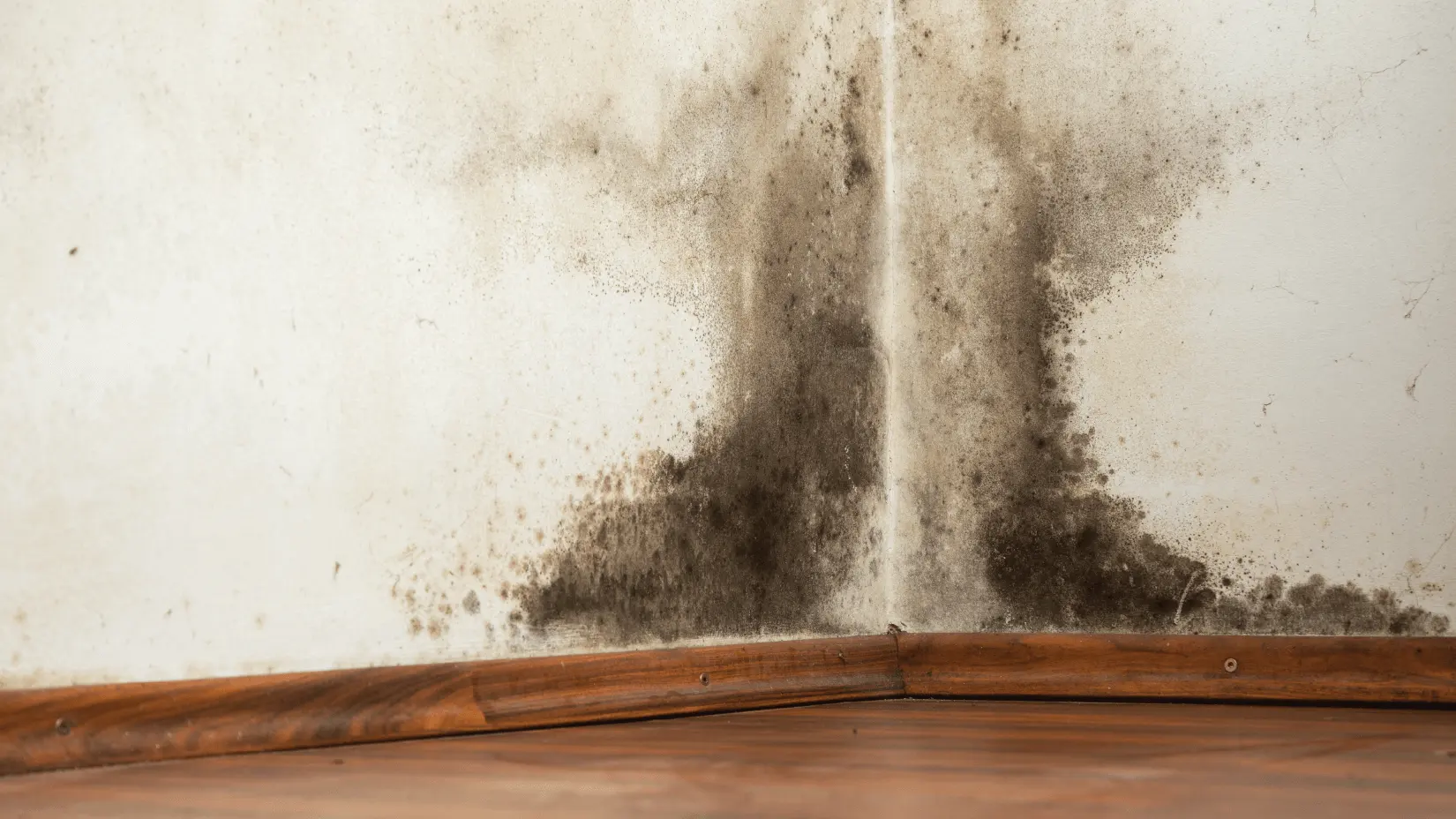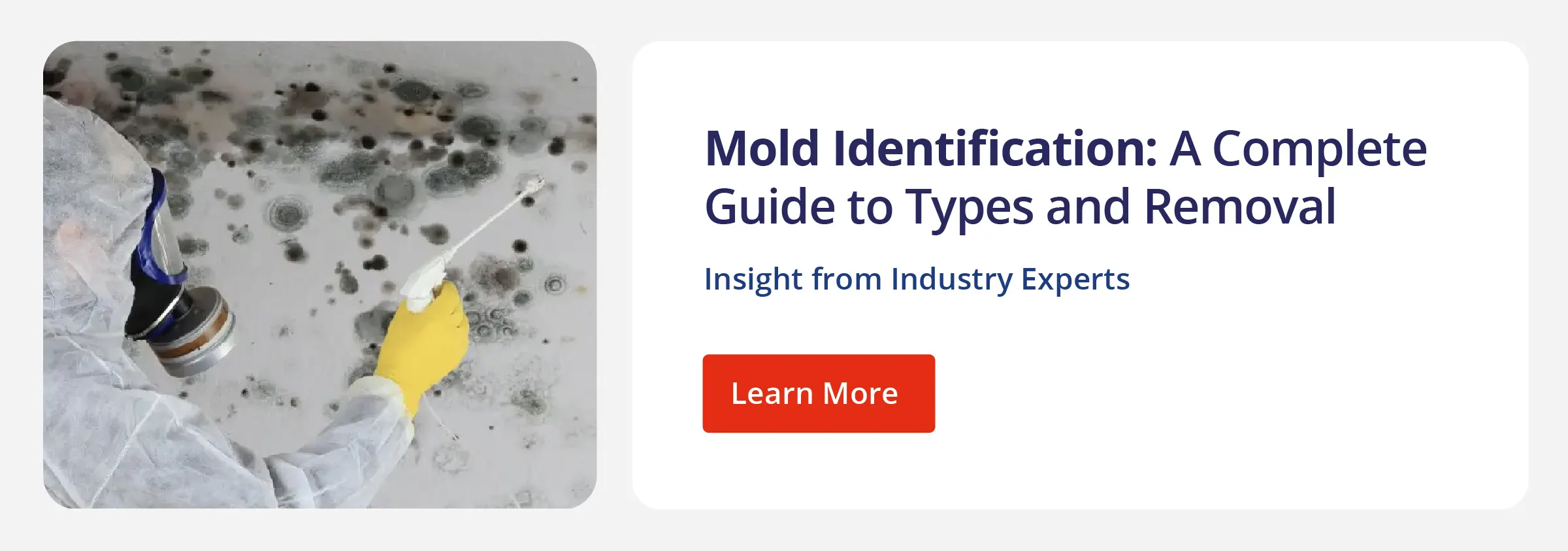
Mildew and mold are common household fungi, but they differ in appearance, health risks, and removal methods. Rainbow Restoration explains the key distinctions.
|
The difference between mildew vs. mold is that mildew grows on top of materials while mold grows into them. Mold is easily identified by a fuzzy or slimy appearance, while mildew typically looks powdery.
When suspicious moldy growth appears in a home or business, it’s important to know whether it’s mildew vs. mold to remedy the issue properly.
But what’s the difference between the two? Mildew is a type of mold that grows on the surface of a material instead of into the material. Mold is also typically more harmful to humans, making it important to know which is growing to ensure a building is safe to occupy.
This article will cover how to identify, treat, and prevent mold and mildew growth to ensure your property is safe to occupy.
Table of Contents:
What Are Mildew and Mold?
Mold is a type of fungus that can grow indoors and outdoors. Mildew is a type of mold most commonly found in moist areas indoors, such as bathrooms.
Although mildew is considered a type of mold, mildew grows differently and is a bit easier to get rid of than other types of mold. Keep reading to discover how to identify whether a suspicious growth is mold or mildew and how to treat the area properly and maintain a healthy environment.
Mildew
Mildew is a specific type of surface-level mold. Unlike mold, mildew doesn’t typically grow into materials making it easier to address. Mildew often looks like a powdery or fluffy patch, especially on organic materials like plants or damp surfaces in bathrooms and kitchens. Mildew is usually white, gray, or light brown.
Like any mold, some people have respiratory or allergic reactions to mildew exposure. It’s important to address mildew as soon as possible to reduce health risks. Fortunately, the health risks are usually not as severe as other molds unless a person is particularly sensitive to mildew.
Mold
Mold is a category of fungi, including various species that thrive in moist environments. This category is extremely diverse — it's found in almost any color and various textures, such as slimy, powdery, or fuzzy. Typically, mold grows in areas with excessive moisture. While kitchens and bathrooms are common culprits, mold can also indicate water leaks or flooding issues.
Mold in a building can cause various issues. Depending on the type of mold and severity of the problem, exposure can make people sick to varying degrees. Mold also grows into materials and breaks them down, which can impact the structural integrity of a building if the issue isn’t addressed properly.
Key Differences Between Mildew and Mold
Mildew is a type of mold, but it’s usually easier to remove and treat. It’s important to distinguish mildew from other, more toxic molds.
.webp)
Appearance and Texture:
The appearance of a suspicious growth can indicate whether it’s mildew or mold. Look out for these signs to help determine which one it is:
- Mildew typically has a powdery or fluffy texture with white or gray coloration. It’s usually flat and remains on the surface without penetrating deeply into materials or spreading.
- Mold has a more varied appearance. It’s often fuzzy or slimy, growing in black, green, pink, or other colors. Mold spreads into materials and breaks them down. This growth pattern is also why mold is much more difficult to remove and often requires professional help.
Location:
The location of the growth can also hint at what it is. Here are the main differences between where mold and mildew grow:
- Mildew commonly grows on organic materials in damp areas, such as paper, leather, and plants. However, it also grows in areas of buildings where moisture is consistently high, even if it’s not on the surface of an organic material, such as concrete in a basement.
- Mold is more versatile and can grow on organic or inorganic materials, including food, walls, and ceilings. It grows in areas where moisture levels have remained high for an extended period, such as a basement, attic, or crawl space.
What Causes Mildew and Mold?
Mold and mildew have the same causes and thrive in the same environment: moist, warm conditions. The following are some of the most common sources of mold and mildew in buildings:
- Leaks
- Flooding
- Condensation
- High humidity
- Poor ventilation
These factors are why it’s so common to find mold in bathrooms, kitchens, and basements. If you suspect mold has developed in one of these areas, call restoration professionals for mold removal and remediation service. An experienced mold remediation professional will confirm if mold is present, properly remove it, and ensure the affected areas are completely dry to prevent any further issues. After completing mold remediation, our service technicians will make sure the source of the mold (a leaky pipe or other issue) is addressed to keep it from growing again.
.webp)
How To Identify Mildew and Mold?
Although mildew is a type of mold, it’s important to distinguish whether a room is growing mold or mildew. Mildew can be easily taken care of with basic household cleaners, but mold usually requires professional remediation to ensure it’s removed safely. The chart below covers the main differences between mold and mildew.
| Mildew | Mold | |
|---|---|---|
| Visual Appearance |
|
|
| Smell |
|
|
| Structural Concerns |
|
|
| Health Symptoms |
|
|
| Testing & Assessment |
|
|
6 Mildew and Mold Prevention Tips
To prevent structural issues and keep inhabitants safe, take these key steps to prevent mold and mildew in a building:
- Monitor humidity levels with a hygrometer and aim for between 30% and 50% humidity.
- Ensure proper ventilation in high-moisture areas like bathrooms, kitchens, and basements.
- Regularly clean and inspect areas prone to moisture buildup.
- Promptly address any water leaks or spills.
- Use mold-resistant products in moisture-prone areas, such as mold-resistant drywall or paints, especially in bathrooms and basements.
- Ensure proper installation of tiles, stone, or grout and seal materials if necessary.
.webp)
Treating Mildew and Mold
If you think you have mold or mildew, it’s best to take care of it immediately. Because mildew grows on top of materials and not into them, you can generally treat it on your own. However, untreated mildew can turn into a much bigger problem.
But because mold grows into materials, it’s safest to hire a mold removal and remediation service to ensure the issue is properly addressed.
DIY Solutions for Mildew
A few different household cleaners can safely remove mildew. Always take the necessary precautions and wear protective gear whenever cleaning up mildew. Open doors and windows if possible to improve ventilation while you’re cleaning.
Mildew Removers (to be used separately)
- Undiluted white vinegar
- 1 cup of bleach per gallon of water
- 50% ammonia solution
- Pre-mixed mildew removal products
Tip: Use one of the solutions above, but never mix different solutions while cleaning to avoid a potentially hazardous chemical reaction.
Steps for DIY Treatment
Using one of the cleaning solutions noted above, follow these steps to remove the mildew:
- Scrub away visible mildew using a rag, sponge, or cleaning brush.
- Liberally spray down the affected and surrounding area with the solution.
- Let the solution sit for 20 minutes.
- Rinse the solution and completely dry the area.
- Take preventative steps such as installing a ventilation fan.
Tip: If you’re using a pre-mixed solution, follow the usage instructions on the label.
Professional Mold Remediation Services
Early signs of mold in a home or business pose an immediate danger to its inhabitants. While mold is believed to cause adverse health outcomes, the cause of the mold may pose a risk to the structure and stability of the property.
If you notice several areas of mold or it’s on a porous surface like plaster walls, always contact a professional removal and remediation. Lack of proper equipment, training, and removal techniques often leads to more damage, health issues, and additional expenses. until you get the issue professionally treated.
Frequently Asked Questions About Mold and Mildew
Which Is Worse, Mold or Mildew?
Mold is typically worse than mildew because it penetrates and damages most material it comes into contact with. Mildew grows on the surface of materials making it much easier to remove. In general, mold is also more toxic than mildew, which presents a greater health risk.
How Do You Know If It's Mold or Mildew?
Mildew has a light gray to white puffy or powdery appearance. Different types of mold grow in many different colors and textures. Common forms of mold are slimy or fuzzy with white, green, black, pink, or yellow coloring. When in doubt, contact a professional to determine whether it’s mold or mildew. An improperly treated mold problem can have devastating health and safety consequences.
Does Mildew Turn into Mold?
According to FEMA, mildew is an early stage of mold growth. Multiple types of mold can grow in the same area making it possible to have an issue with mildew and mold at the same time.
What Color Is Toxic Mold?
Black mold, or Stachybotrys chartarum, grows in colors from dark green to black and is infamous for its toxicity. This mold has a slimy texture and gives off a musty odor.
.webp)
Learn How Rainbow Restoration® Can Solve Your Mold Problem
When dealing with mildew or mold, don’t take any risks with the health and safety of a property. Your local Rainbow Restoration has the expertise, training, and the proper equipment to remove mold safely and restore the space to its best possible condition.
This article is intended for general informational purposes only and may not be applicable to every situation. You are responsible for determining the proper course of action for your property. Services should be performed by licensed and experienced professionals. Rainbow Restoration is not responsible for any damages that occur as a result of this blog content or your actions. For the most accurate guidance, contact a Rainbow Restoration professional for a custom, on-site assessment.

